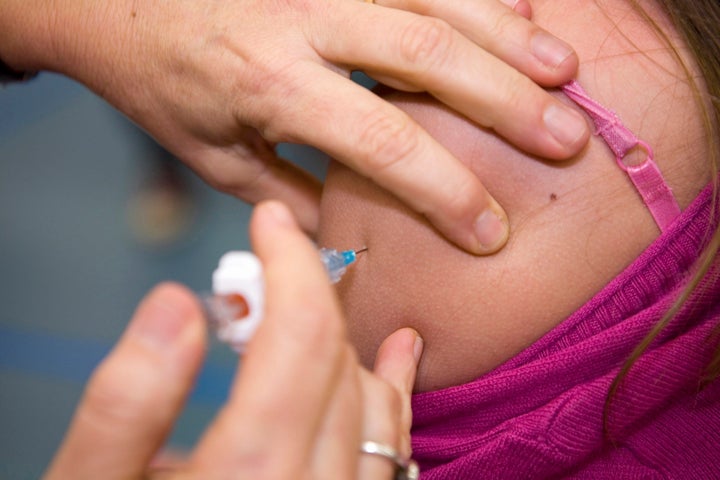
Researchers who study vaccine rates for human papilloma virus, the cancer-causing sexually transmitted infection, are puzzled and alarmed at how low the vaccination rates really are. They speculate that everything from suspicion about new vaccines to apprehension about discussions on sexual activity may be causing parents to reject the shots for their children.
But a new online survey conducted by researchers at Harvard Medical School and the University of North Carolina at Chapel Hill finds that pediatricians may, in fact, play a role in the low vaccine rate.
Of the 776 pediatricians and family doctors surveyed across the nation, 27 percent said they don’t endorse the vaccine strongly and 49 percent said they don’t emphasize urgency by offering the first shot on the day they see a patient.
This is disturbing considering past research that shows recommendations from health care providers are an especially strong factor in people’s decisions to get the vaccine.
The vaccine, typically administered in three doses, is recommended for people ages 11 to 12 to make sure that they are protected as soon as they begin having sex.
But in 2014, only about 60 percent of girls age 13 to 17 had received at least one dose of the vaccine, while only 39.7 percent had received the recommended three doses. The rates are even worse for boys; in 2014, only 41.7 percent had received at least one shot, and only 21.6 percent had completed all three. The Centers for Disease Control and Prevention estimates that if U.S. teens could achieve 80 percent vaccination rates, the country would avoid 53,000 future cervical cancers.
About 40 strains of HPV cause sexually transmitted warts in the anal and genital areas, while 13 strains can cause cancers of the cervix, anus, throat, vagina, vulva and penis. Worldwide, more than 600,000 new cancer cases are caused by HPV every year.
There are two different types of HPV vaccines. Gardasil, the most common, is recommended for both boys and girls and protects against either nine or four of the most dangerous HPV strains, depending on which version is chosen. Cervarix, recommended only for women and girls, protects against two strains.
Both vaccines protect people against the HPV strains that most commonly cause cancers. While getting these shots might sound like an obvious choice for parents, the physician survey highlighted a few reasons for the lag.
Gender difference
Thirty-nine percent of doctors brought up the vaccine for boys either behind the recommended schedule or not at all, while that number was 26 percent for girls. Timing is important for the HPV vaccine because the virus is so widespread; about one in four people in the U.S. are infected with at least one of over 100 strains of HPV.
Focusing on risk assessment
Another problem is that 59 percent of doctors also took a “risk-based” approach to the shots, which is when doctors offer the shots only to teens that they think are at higher risk of getting a sexually transmitted disease, rather than all of their pre-teen patients. While risk-based approaches are the norm for most medical procedures, they aren’t recommended for vaccines, which work best when the entire population gets them (barring those with medical exceptions). And children see the doctor less and less as they grow into adolescence, providing fewer opportunities to vaccinate.
By the time girls are in their late teen years, about one-third of them have at least one strain of the virus at any given time. Most people will clear the infection on their own, but some strains will go on to become cancer or result in recurring genital warts — two serious outcomes the vaccines can prevent.
"It’s hard to predict when adolescents will be exposed," said study author Melissa Gilkey, an associate professor of population medicine at Harvard Medical School and Harvard Pilgrim Healthcare Institute. "The provider may be thinking, ‘Well, we’ll get to it at the next visit,’ but then there isn’t a next visit, or the next visit comes too late."
"The guideline is not to make the recommendation based on risk," explained Gilkey. "The ideal is for all 11- and 12 year-olds to get the recommendation."
Doctor confusion
A sizable minority of doctors are framing HPV vaccines as an “optional” vaccine, or at the very least are notoriously inconsistent about the vaccines. One of Gilkey’s past studies, among Minnesota health care providers in 2014, found that 47 percent of doctors felt they lacked the time to discuss the reasons behind a parent’s refusal, and 55 percent doubted they could change a parent’s mind on the issue.
The participants in Gilkey’s current sample were mostly long-time physicians; over half of them had more than 20 years of experience. The doctors who were the strongest proponents of the HPV vaccine had two things in common: They had a direct, presumptive tone about the vaccines (i.e. "Your child is due for the shots") as opposed to a participatory tone, and they rattled off a thorough description of the things the vaccine prevents (cervical cancers, other cancers and genital warts).
"Some qualitative studies suggest that a lot of parents appreciate a straightforward, unambiguous recommendation," Gilkey concluded. "If providers provide more recommendations, and higher quality recommendations, it could really go a long way to increasing HPV vaccination coverage."
